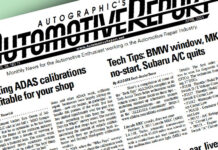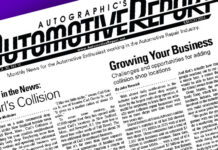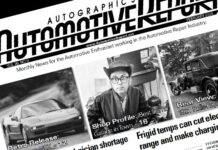Ideas That Have Proven Successful For Bod Shops
By John Yoswick
You can’t talk with other shop owners anywhere without gaining some good ideas that might work for your own shop. Here are some tips and ideas from seven successful collision repair businesses.
Buy your property, view business as a game
Unlike many who became shop owners after working as a technician, Brady Lander did so after earning a business degree. As a student in 2001, he’d interned in a body shop because of his interest in vehicle restoration, and decided to buy the business when he learned the owner was retiring.
Now Brady’s Auto Body in Vancouver, Wash., has grown to employ more than a dozen people working in a 14,000-square-foot shop Lander built about a decade ago. Lander’s No. 1 piece of advice to other shop owners is to find a way to buy their own land and building.
“If you’re in a lease with someone else, your fixed costs are stuck,” Lander said. “If you can own your own land and pay it off, you have flexibility. I can choose to not pay myself rent for a couple months, so you can control your costs.”
Lander said he also has the flexibility of owning an adjacent parcel of land as well.
“We could put another 9,000 square feet up there, and we already have that permitted,” he said.
Lander said he understands why some people complain about the challenges in the collision repair industry, but for him, “attitude is everything.”
“It’s all about your outlook,” he said. “I like the industry. It’s fundamentally a chess game, and the insurance company is playing one move and we’re playing another. If you build relationships, I think you can really put out a great product for customers and make them happy and just figure out how to play the game. If you take personally what adjusters do, you’ll go nuts. And if there were no insurance companies, you’d have to sell a customer on why they need to spend $5,000 to fix their car. They’re not going to just write the check. But insurers have the money. You just have to get them to realize why they need to give it up.”
Get outside help if needed, invest in good equipment
Roger Fowler didn’t actively seek out a business consultant to help him, but he’s nonetheless satisfied with the business improvements that a consultant he ended up working with helped him implement at J&W CARSTAR, located in McMinnville, Ore.
“If I thought about how much it was going to cost, I might have said, ‘No,’” Fowler said in hindsight. “But in the end, it’s paying for itself. It worked. So it’s not always the cost. It’s the return.”
Several years ago, after more than 24 years of operating his shop, Fowler said he found himself feeling burned-out and at times “frustrated with everything.”
“I was thinking about how do I transition out of here, when I got one of those cold calls,” Fowler said.
The call Fowler received was a consulting firm that he subsequently hired to work with the shop’s entire staff of 12 as Fowler promoted an estimator to general manager, restructured bonus plans for the front office, and helped everyone in the company understand their role in the shop’s business performance.
“They were here eight or nine hours a day, every day,” Fowler said of the consultants he hired. “They dug into it. We involved all our employees, showed them how profitability happens. We had a good organization, and a good supply of work, so we just showed them how they can all benefit by doing every part of their job right and keeping costs in mind. We showed them how little changes can make a difference in profit. That’s been a huge switch since that summer. Since then we’ve been rocking. We were good up to then, but since then, we’re way better.”
He said the change has been far more of a win in his mind than selling the business to a larger repair chain.
“I care about my people, and they are all happy we’re doing it this way rather than selling,” Fowler said.
Fowler’s other advice to shop owners: “Buy good equipment because it produces every day, day-in and day-out,” he said. “It doesn’t call in sick very often.”
Shop addition helps attract drive-by business
Anyone who isn’t convinced that a visible, high-traffic location can’t help a body shop’s business should talk with Bob Miller of Treasure Valley Collision Center in Boise, Idaho.
Miller said an addition he built on a vacant lot across the parking lot from his shop has helped his business in two ways. Now with a combined 14,000 square feet, the addition obviously boosted the shop’s production capacity. But since it’s completion early last year, the addition itself has also significantly improved the shop’s visibility and sales.
“Just adding this new building has increased our drive-by revenue by about five percent,” Miller said. “About 38,000 cars drive by here every day.”
He believes the shortage of new talent entering the industry is definitely a key issue. He’s used good benefits to help retain many of the employees that started with him 10 years ago. But he also sees the average age of technicians creeping up, and so has an apprenticeship program at each of his shops for students at a nearby college where he volunteers.
“I really think that we as body shop owners need to work with the instruction that’s going on at the colleges,” he said. “We’re working hard so [students] can understand more of what happens in a body shop. We’re trying to help the schools prepare them for when they come in here.”
Siblings honor tradition at second-generation body shop
Nancy Yeager, who owns and operates Cupertino Body Shop in California with her two siblings, said that as second-generation shop owners, they try to assist those on a budget find a way to afford the repair work they need, sometimes even doing simple, while-you-wait fixes at no charge.
“We try to help people as much as possible,” Yeager said. “There are some people who obviously can’t afford to get their cars done completely. We work with a lot of elderly people. When I see them, I picture my Mom and Dad, so we’re going to help them as much as possible. That’s how my Dad ran the business. That’s how he got customers. People remember that. We’ve had multiple generations of customers now. They still tell us things they remember that Dad did for them.”
Collision repair work propels former ‘restoration-only shop’
Todd Fortier said at times he’s been surprised at the response he’s had to the focus of much of the advertising for Todd’s Auto Body in Springfield, Ore.
“My message has always been: ‘It’s not the insurance company’s car. It’s your car. We work for you.’ And it doesn’t bother the insurance companies that I say that,” Fortier said. “It’s actually only been a lot of the other body shops in town that think I’m crazy to say that. But that’s been a lot of our success—really caring our about customers and their cars.”
That effort and marketing appears to be paying off for Fortier, with the opening last year of a second shop just across the street from their existing location. The new shop had previously been a body shop that shut down a few years ago, Fortier said. Before opening, he did a significant remodel, including opening an indoor estimating bay with a lift and windows into the rest of the shop’s offices.
Fortier for years had focused primarily on restorations and vehicle customization, and the company still always has some of those types of jobs in-process. But when the economy changed several years ago, Fortier began adding insurance-paid collision repair work into his shop’s mix, and the owners of the classic and custom vehicles he’d worked on were thrilled.
“Once they found out he was doing insurance and regular collision work as well, he was their go-to guy,” estimator and office manager Leighann Romero said of Fortier.
Diversification is key to shop’s success
Aluminum vehicles don’t worry Joe Wheeler of Wheeler’s Collision and Paint in Kelso, Wash., because of the diversification of his business. In addition to standard passenger vehicle collision repair work, Wheeler’s offers complete mechanical work as well as repair of recreational vehicles and heavy-duty trucks.
“We’ve been dealing with aluminum structural repair on these big semi-trucks for years,” he said. “We do a lot of aluminum welding as it is now.”
Wheeler said his business philosophy of avoiding debt combined with the company’s diversification has helped the business weather downturns in the economy more easily than other businesses. Mechanical work, in particular, he said, allows the shop to offer customers more services—and at work at rates not controlled by insurance companies. Though he’d like to build a second building exclusively for mechanical work, for now his mechanical technician has a well-equipped stall in the collision shop.
“And you actually almost need that in collision repair today because the vehicles are all so specialized,” Wheeler said. “I don’t know how any shop can do it without it a full-time mechanic.”
Efficiencies gained through training
Sharree Strausbaugh said she recently invested $5,000 in employee training and can’t understand why more shops aren’t maintaining the I-CAR Gold Class designation.
“We’re all about education here,” Strausbaugh said, adding that some I-CAR courses are even being held at her shop, A&M Autobody in Eugene, Ore. “Technology is moving so fast. Plus I-CAR is really starting to come into its own. In the past we’d hear complaints, but now our guys are coming back excited about these classes.”
Is she concerned that she won’t see a return on that investment in her 16 employees if they leave her shop after she has paid for their training.
“Well, first, we’re like a family around here. We have very little turn-over,” she said. “We’ve retired three people after 40 years here. We did ask two people who we re-certified in welding, which is spendy, to agree to pay us back for that if they leave within four years. But otherwise we pay for it.”
Strausbaugh has owned and operated the shop for 16 years, purchasing A&M with a background in business but no collision repair industry experience. She takes pride in the fact that what was a long-standing but still uncomputerized business when she bought it is now among the most state-of-the-art in the industry, including being one of only 850 independent shops in the country designated by Ford as “aluminum-ready.”
She actually credits the past economic recession for her shop’s ability to now invest that way in its own future.
“We looked at everything to cut our costs in order to survive through that,” Strausbaugh said. “Everything, right down to counting every rag in the paint room and switching from having our rugs changed weekly to biweekly. I learned a lot through that process. Now on the other end of it, we’ve been blessed—and I use that word, blessed. It helped us create cost efficiencies that have helped us be able to move into the future.”
Strausbaugh said the best equipment means nothing without good people, processes and procedures in place. She said that the shop’s cycle time always compares favorably with the market-wide statistics she sees, in part because of smarter scheduling.
“I would say that 80 percent of the shops around the country still does the ‘in on Monday, out on Friday’ method of scheduling,” she said. “That’s totally a thing of the past here. We only schedule through our system, which is based on our capacity for each day. That has made a huge difference. Consistently, month after month, our cycle time beats everyone else in the area.” •
John Yoswick, a freelance writer based in Portland, Ore., who has been writing about the automotive industry since 1988, is also the editor of the weekly CRASH Network (for a free 4-week trial subscription, visit www.CrashNetwork.com). He can be contacted by email at jyoswick@SpiritOne.com.



